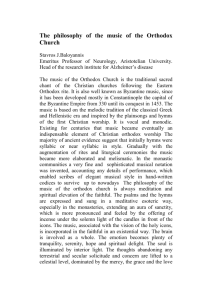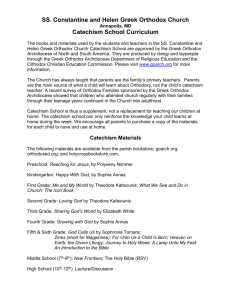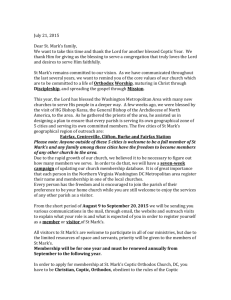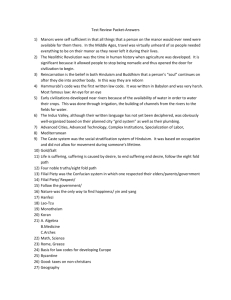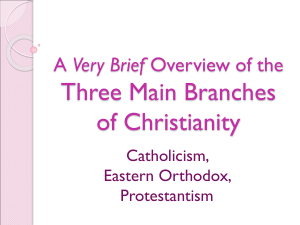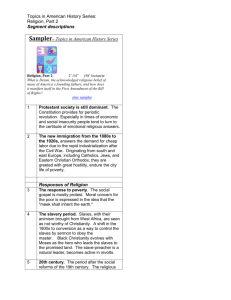Orthodox churches D
advertisement
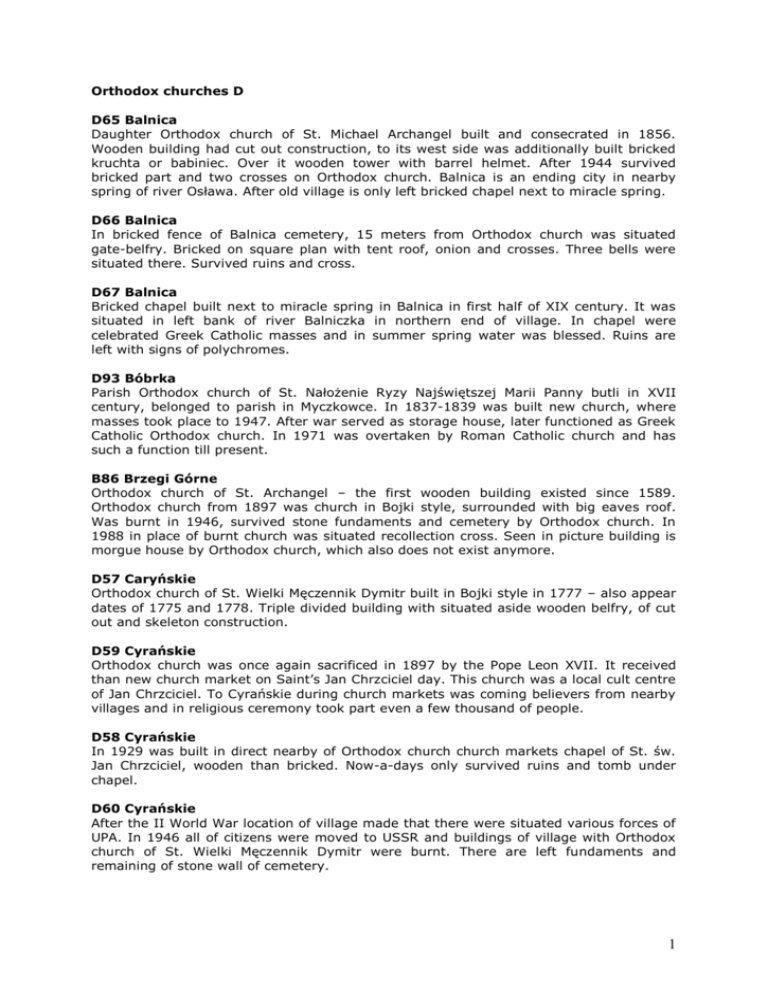
Orthodox churches D D65 Balnica Daughter Orthodox church of St. Michael Archangel built and consecrated in 1856. Wooden building had cut out construction, to its west side was additionally built bricked kruchta or babiniec. Over it wooden tower with barrel helmet. After 1944 survived bricked part and two crosses on Orthodox church. Balnica is an ending city in nearby spring of river Osława. After old village is only left bricked chapel next to miracle spring. D66 Balnica In bricked fence of Balnica cemetery, 15 meters from Orthodox church was situated gate-belfry. Bricked on square plan with tent roof, onion and crosses. Three bells were situated there. Survived ruins and cross. D67 Balnica Bricked chapel built next to miracle spring in Balnica in first half of XIX century. It was situated in left bank of river Balniczka in northern end of village. In chapel were celebrated Greek Catholic masses and in summer spring water was blessed. Ruins are left with signs of polychromes. D93 Bóbrka Parish Orthodox church of St. Nałożenie Ryzy Najświętszej Marii Panny butli in XVII century, belonged to parish in Myczkowce. In 1837-1839 was built new church, where masses took place to 1947. After war served as storage house, later functioned as Greek Catholic Orthodox church. In 1971 was overtaken by Roman Catholic church and has such a function till present. B86 Brzegi Górne Orthodox church of St. Archangel – the first wooden building existed since 1589. Orthodox church from 1897 was church in Bojki style, surrounded with big eaves roof. Was burnt in 1946, survived stone fundaments and cemetery by Orthodox church. In 1988 in place of burnt church was situated recollection cross. Seen in picture building is morgue house by Orthodox church, which also does not exist anymore. D57 Caryńskie Orthodox church of St. Wielki Męczennik Dymitr built in Bojki style in 1777 – also appear dates of 1775 and 1778. Triple divided building with situated aside wooden belfry, of cut out and skeleton construction. D59 Cyrańskie Orthodox church was once again sacrificed in 1897 by the Pope Leon XVII. It received than new church market on Saint’s Jan Chrzciciel day. This church was a local cult centre of Jan Chrzciciel. To Cyrańskie during church markets was coming believers from nearby villages and in religious ceremony took part even a few thousand of people. D58 Cyrańskie In 1929 was built in direct nearby of Orthodox church church markets chapel of St. św. Jan Chrzciciel, wooden than bricked. Now-a-days only survived ruins and tomb under chapel. D60 Cyrańskie After the II World War location of village made that there were situated various forces of UPA. In 1946 all of citizens were moved to USSR and buildings of village with Orthodox church of St. Wielki Męczennik Dymitr were burnt. There are left fundaments and remaining of stone wall of cemetery. 1 D76 Chmiel Parish Orthodox church of St. św. Mikołaj initially dated in 1584. The following one, the second Orthodox church was built in place of old one in 1795, existed till 1904. The last one, wooden Orthodox church was built by citizens in 1904-1906, consecrated in following year – 1907 – with initial of św. Mikołaj. It was triple divided Orthodox church of cut out construction, two zachrystia. Single domed building 0 dome over nave and over entrance and presbytery not too big tower. In outcome of resettlement of people in 1947 Orthodox church was left. After 1951 equipment of Orthodox church was stolen and building was changed into storage house of fire brigade. In 1969 after long efforts building was appointed for Roman Catholic church and has this function till present. D31 Cisna Parish Orthodox church of St. św. Michael Archangel in Cisna was built in 1825 of count Julian Fredro foundation. Wooden Orthodox church was renew in 1902. Building of Orthodox church existed until 1956. D32 Cisna Belfry next to Orthodox church was built in 1825 as wooden building, pillar, covered with tent roof. In post war times served volunteer fire brigade. It was deconstructed in ’70. D33 Cisna Orthodox church of St. św. Michael Archangel was double divided church. Now-a-days only survived clearly visible fundaments. XVIII century icon of Przemienie Pańskie from Orthodox church in Cisna is located in Historical Museum in Sanok. D13 Czarna Wooden skeleton belfry was built in Czarna after 1951, encompassed bell from 1886. Other historical monuments of Orthodox church now-a-days are located in museums of Łańcut and Sanok. In cemetery of Orthodox church are left a few historical tombs. D91 Dobromil Dekanat Dobromil is now-a-days city in west Ukraine in Lvev region, approximately five kilometers form border with Poland. The first signs about village settled by Herbut comes from 1374. Civic rights were granted in 1566. Stanisław Herbut was one of the founders of Unitary monastery according to rules of Saint Bazyly in Dobromil. In inside of church was ornamented with pictures Herbut family. Dobromil Dekanat existed since XVI century. D85 Dołżyca near Komańcza Greek Catholic road chapel with tent roof. After Orthodox church of St. św. Michael Archangel in Dołżyca ni signs of existence survived. D89 Dwenik Parish Orthodox church of St. św. Michael Archangel - the first signs about Orthodox church in this place are dated on 1533. The last wooden Orthodox church was built 1785, renew in 1898. Triple divided church covered with brogowy roof, in babiniec and presbytery part with kalenica roof. Orthodox church was burnt in 1946, only survived remaining of fundaments. Place after wooden Orthodox church and rest of cemetery are situated next to bus stop. D84 Hoczew Parish Orthodox church of St. Wniebowstąpienie Pańskie was built in 1798, founded by squire Józef Bobkowski. Wooden building covered with shingles, triple divided with three times broken roof. Orthodox church was deconstructed circa in 1905 and in its place was built bricked one. 2 D51 Hulskie Daughter Orthodox church of St. św. Paraskiew was built in 1920 as bricked building. Now-a-days only survived remaining of walls. D52 Hulskie In 1952 aside Orthodox church of St. Paraskiew was built bricked belfry, two storey with three closed arcades opened from east side. Till present remained its bricked part. D83 Lesko Parish Orthodox church of St. Sobór Matki Bożej and św. Mikołaj in Lesko bricked in 1837, consecrated in 1846. In front were two wooden buildings. Church was renew in 1905. After ending of war activities equipment was transported to Ukraine and building had role of storage house. In 1960-1962 Orthodox church was deconstructed and in its place is situated now-a-days building – office of PKO BP bank as well as PZU insurance. D24 Liskowate Parish Orthodox church of St. Narodzenia Bogarodzicy built and consecrated in 1832. The first signs are dated on 1564. Orthodox church had additional chapel with iconostas of St. św. Dymitr. Over threshold of south doors survived inscription of foundation in Old Russian language. D25 Liskowate Greek Catholic Orthodox church of St. Narodzenie Bogarodzicy was probably built in 1832, significantly rebuilt during repair in 1929. Orthodox church built on stone fundaments, wooden, cut out construction, zachrystia of so called pastoforia. Nave is as wide as sanctuary with zachrystia. Two storey babiniec is higher. Initially upper storey made chapel and belfry. Orthodox church in Liskowate in 1953-1973 served as storage house of fertilizers. In spit of repairs and conservatory works it could not be renovated into initial state. Now-a-days Orthodox church has function of daughter Roman Catholic church. XVII century icons were transported from Orthodox church and are now located in Museum – Castle in Łańcut. D34 Liszna Daughter Orthodox church of St. Ofiarowanie Najświętszej Marii Panny built and consecrated in 1835. Wooden building covered with tent roof with three towers. D35 Liszna Renew in 1928 Orthodox church in Liszna was completely destroyed in 1945. Only survived remaining of fundaments. Orthodox church’s cemetery was also completely devastated. D79 Lutowiska Parish Orthodox church of St. św. Michael Archangel was built in 1799 of foundation of count Józef Górski. It was rebuilt after fire in 1898. It was big, triple domed church with transparent. It was closed in 1951, fall into ruin, equipment was stolen. In 1980 remaining of walls of building were deconstructed, it was assigned for building of church in Dwernik. In church in Dwernik is also situated painted on steel painting of Saint Michael form Lutów Orthodox church. D11 Łopienka Parish Orthodox church of St. św. Męczennik Paraskewi. Built in 1757 of Strzeleccy family foundation became one of the most famous centre of God’s Mother cult in west Bieszczady. D12 Łopienka Chapel next to Orthodox church in Łopienka, bricked on rectangular plan from half circled absyda, covered with kalenica roof. Reconstructed in 1994. 3 D13 Łopienka According to tradition the first place of cult in Łopienka was chapel of miracle icon of God’s Mother of Łopienka from the first half of XVIII century. After 1947 icon and main alter were transported to Polańczyk. D14 Łopienka Typical XIX century shape of Orthodox church in Łopienka connects with low absyda, which is remaining after the first bricked chapel. In post war times Orthodox church fell into ruin. Since ’70 were conducted successively reconstruction and conservatory works. Since 1995 building is rebuilt. D82 Łupków Parish Orthodox church of St. św. Michael Archangel in Łupków was built in 1815 and 1829, consecration was celebrated in 1858. It was triple divided building with additionally built tower. It was destroyed in 1944, survived clearly visible fundaments, ruins of belfry, fence of mountain blocks. D8 Manasterzec Parish Orthodox church of St. Przemienienie Pańskie in Manasterz built in 1818. The first signs about existence of Orthodox church in this place appeared in 1761. In 1932-1935 church was rebuilt adding west tower and octagonal barrel over nave. D9 Manasterzec In survived cemetery in east part of Orthodox church is situated bricked cemetery chapel as well as tomb of parish priest of Seweryn Dobrjański (1857-1925). D10 Manasterz To 1955 in Orthodox church of St. Przemienienie Pańskie was situated iconostas, main alter and two sides alters from beginning of XX century. In ’60 in it inside was located storage house of apples. Since 1968 is used as daughter of parish of Roman Catholic church in Berzmiechowa. D26 Maniów Parish Orthodox church of St. św. Mikołaj was a wooden building, triple divided, built on long plan. Nave and presbytery were covered with kalenica roof covered with barrel helmet. D29 Maniów Church in Maniów was built in 1841 – 1842. Destroyed after 1944. Only survived visible fundaments of building and belfry. D30 Maniów Bricked chapel aside Orthodox church of St. św. Mikołaj was built in 1914. It was than celebrated Greek Catholic masses in it, now-a-days has function of Roman Catholic chapel. D53 Posada Leska Orthodox church of St. Narodzenia Bogarodzicy already existed in Posada Leska in 1511 as parish Orthodox church for whole Lesko. Entrance of church was built in 1575. D54 Posada Leska In 1575 was built on cemetery hill a new Orthodox church of larch wood. In inside existed historical iconostas and miracle icon of God’s Mother with Jesus – target of pilgrimage from Galicja and Slovakia. 4 D56 Posada Leska After war Orthodox church in Posada Leska was deconstructed and miracle icon was transported to Stryja in Ukraine. Till present survived fundaments in commune old cemetery and two oaks aside place after church. D100 Posada Leska In ’30 was started building of a new Orthodox church in Posada Leska, although it was never finished. Walls were built of believers funds, were detonated in 1946. D101 Posada Leska Miracle icon of God’s Mother with Jesus. According to legend it appeared in cemetery, on stump of cut oak. From that is location of church on cemetery hill, stump of oak was bricked into main alter. D21 Rajskie Parish Orthodox church of St. św. Paraskewii. The first signs are already situated in documents from 1493. Bricked church was built in 1872 0 1875 as double divided church with tower from west side. Building covered with kalenica roof, tower ornamented with barrel helmet. D28 Rajskie During war time activities Orthodox church in Rajskie was damaged with bullets. After 1951 belongings of Orthodox church were stolen and building fell into ruin. On 24 th March 1980 church was detonated, just after citizens asked authorities to handle it for church. Ruins and iron crosses coming from roof are left. Ruins and cemetery of Orthodox church were renew in 1994. D15 Rasolin Daughter Orthodox church of St. św. Onufry was built in 1750. Its foundator was Onufry Giebułtowski, that time owner of village. The first signs about previous Orthodox churches in this place come from 1580. Group of Orthodox churches from Rosolin include three buildings: church, belfry and morgue house. In November 1956 for statement of Museum in Sanok was granted allowance for moving Orthodox church to created outdoor museum aside Sanok. D16 Rasolin In 1957 unique buildings – Orthodox church, wooden belfry screen and wooden cut out morgue house – were moved to Folk Buildings Museum in Sanok. Orthodox church in Rosolin was the first building deconstructed in this area and built after conservatory in outdoor museum – 1960. D105 Skorodne Parish Orthodox church of St. św. Paraskewii is single spaced building on long plan. On kalenica roof had octagonal belfry. Built in 1838 survived to 1951. After was served as grain storage house. In 1972 was completely destroyed by prisoners of jail in Skorodne. Two icons from Orthodox church are now-a-days situated in Museum on Sanok. D104 Smerek Parish Orthodox church of St. Wielki Męczennik Dymitr is triple divided, wooden building built in 1875. During war time activities fell into ruin. In area of Orthodox church were situated double storey belfry covered with brogowy roof and chapel of St. Narodzenie Najświętszej Marii Panny from 1903. Those building did not also survived. D20 Smolnik near Lutowiska Parish Orthodox church of St. św. Michael Archangel was built in centre of village in 1791. In inside were situated polychromes from end of XVIII century and painting of God’s Mother painted on board in 1748. It’s the oldest of this type – of Bojki – Orthodox 5 church in Poland survived in initial place. Orthodox church survived in excellent state, next to it not too big old cemetery. Now-a-days functions as Catholic church. Previously in nearby were situated many buildings, Orthodox church as well as steam sawmill, although in 1950 – 1960 all of buildings were deconstructed, only Orthodox church is left. It’s worth to recall that since ending of the II World War Smolnik belonged to USSR. It was once again included to Poland in 1951. D68 Solina Daughter Orthodox church of St. Przemienienie Pańskie in Solina existed since 1828 until 1961, when it was deconstructed bound with building of Solina Zalew. Equipment of Orthodox church was transported to museums of Łańcut and Sanok. Icon of Przemienienie Pańskie is situated in National Museum in Guców. D69 Solina Orthodox church in Solina was double divided church with triple side presbytery. In 1937 was built a new wooden building in place of cult from XIX century. Place after Orthodox church is situated now-a-days under water of Solina Zalew. D94 Średnia Wieś – inside In Orthodox church of St. Zaśnięcie Matki Boskiej was situated small alter from the first half of XVII century and in it icon of God’s Mother with Jesus surrounded with openwork frame. Now-a-days alter is situated in treasury of church in Hoczwia. D72 Stężnica Daughter Orthodox church of St. św. Mikołaj Cudotwórca was built in 1824, renew in 1930. It was double divided building with presbytery, nave and lower additional building of treasury and zachrystia. In south-east side of Orthodox church buildings was situated morgue house. Orthodox church was deconstructed in 1947. D73 Stężnica Chapel in nearby of Stężnica. Now-a-days does not exist anymore. D80 Stuposiany Daughter Orthodox church of St. Opieka Matki Bożej in Stuposiany was built in 1737, it was building in Bojki type with twice broken brogowy coverage. After 1945 was destroyed, tombs of cemetery were used for building road in Tarnawa direction. D62 Szczerbanówka Daughter Orthodox church of St. św. Dymitr in Szczerbanówka was built in 1857, consecrated in 1858. Was completely destroyed in 1944 during war time activities. Survived not readable signs of fundaments. D61 Szczerbanówka Bricked belfry of Orthodox church of St. św. Dymitr was situated between entrance to Orthodox church and west part of fence. Survived rests of walls. D70 Tworyle Daughter Orthodox church of St. św. Mikołaj – the first signs could be found in documents from 1526. The last triple divided building with presbytery, nave and babniec was built in 1876. D71 Tworyle In surrounding of buildings were situated apart from Orthodox church: bricked belfry with arcades as well as chapel of St. Przemienienie Pańskie. All of the buildings were destroyed after 1945. Survived stone fundaments, ruins of belfry and tomb under chapel. 6 D44 Tyskowa Daughter Orthodox church of St. św. Michael Archangel was a wooden building belonging to Cisna Dekanat. Orthodox church had features of Łemki style in east type – building on long plan with each room of buildings in square plan. Each parts of Orthodox church has equal height and width. Roof which covers it was double sloped usually single kalenica. D43 Tyskowa Orthodox church in Tyskowa was built in 1837 (or as other sources state in 1831) as wooden building of stone fundaments. Orthodox church did not have tower, only blind belfry over nave. To Orthodox church went stairs of sandstone plate. D42 Tyskowa Inside of Orthodox church of St. św. Michael Archangel. D45 Tyskowa The first Orthodox churches were wooden buildings, wood was the most common material. Timbers were used of boards of shingles coverage. D46 Tyskowa After 1947 citizens of Tyskowa were resettled and buildings of village were destroyed together with Orthodox church. Survived fundaments of Orthodox church, cross on dome as well as a few destroyed tombs at aside Orthodox church cemetery. D48 Tyskowa Project of rebuilding of Orthodox church of St. św. Michał shows changes in Łemki style – additionally built on cut out of babiniec pillar tower with overhanging izbica. Each of three parts were covered with roof of octagonal Baroque helmet, what emphasizes triple division of building. D17 Ustaniowa Góra Parish Orthodox church Of St. św. Paraskewii. The first signs about it comes from 1526. Now-a-days wooden church comes from 1792 with survived inscription on rainbow board. It is triple divided building of cut out construction, walls and roof covered with shingles. Used until 1951. The whole equipment was transported to outdoor museum on Sanok. Since 1971 after total repair and restoration has function of parish church of Roman Catholics. In inside historical stone font form 1862. D102 Ustaniowa Dolna Daughter Orthodox church of St. św. Paraskewii. It’s unknown precise date of its building – probably in 1892. It was wooden church situated in west part of village. It was deconstructed in 1953. D37 Ustrzyki Dolne Greek Catholic Orthodox church, bricked, built in 1847, renew and once again used in 1986. Aside Orthodox church was built in 1988 two wooden crosses commemorating 950 years of Baptizing of Russia. Now-a-days it’s church of Byzantium-Ukraine church. D87 Ustrzyki Dolne Parish Orthodox church of St. Zaśnięcie Matki Bożej in Ustrzyki Dolne built and consecrated in 1847. After repair in 1937 was used as Orthodox church until ’50. For two years had function of church and since 1953 served as storage house. Devastated and destroyed building was handled in 1980 local Greek Catholic parish. After repair and conservatory works Orthodox church functions until present, masses of East Church are celebrated. 7 D23 Wańkowa Parish Orthodox church of St. św. Paraskewii in Wańkowa. Probably existed until the moment of location of village before 1483. The last reconstruction of wooden church is dated on 1792. Larch Orthodox church was totally renew in 1932, in post war times was left and deconstructed for storage house. In 1963 – 1976 was made total deconstructing of Orthodox church and XVIII century belfry. Survived steel cross from helmet covering Orthodox church and cemetery with four tombs form XIX and XX century. D74 Wola Michowa The first signs about Orthodox church in Wola Michowa comes from 1530. The last parish Orthodox church of St. św. Mikołaj was built in 1843. Deconstructed in 1747, in place of buildings are left four old linden and ash trees. D75 Wola Michowa Belfry of Orthodox church of St. św. Wielki Męczennik Dymitr – the first signs about Orthodox church could be found in documents from 1676, the oldest building existed till 1735. D40 Wołosate Next – seen in photo – wooden Orthodox church was built in Wołosate in 1837. D41 Wołosate Orthodox church of St. św. Wielki Męczennik Dymitr was a building in Bojki’s Orthodox church style with broken brogowy roof. Church was burnt in 1946. Survived fundaments and cemetery tombs which renovation was made in 1991. D81 Zadworze Orthodox church chapel in Zadworze village. Village did not had its own Orthodox church, in spite the fact that in 1938 enumerated 248 citizens. D98 Zahoczewie Parish Orthodox church of St. św. Michael Archangel existed since 1463. Bricked church from 1934 was fourth in a row building built in the same place. Orthodox church on long plan covered with dome with not too big crosswise transept. In post war times left Orthodox church was tried to be overtaken by Roman Catholic church, at the beginning of ’50 it was deconstructed though. Survived only fundaments of Orthodox church and cemetery with a few tombs. D49 Zatwarnica The first signs about parish of St. Przeniesienie Relikwi Świętego Mikołaja in Zatwarnica appeared in 1588. The last building of Orthodox church was built in 1774. D50 Zatwarnica Orthodox church in Zatwarnica was burnt in 1946 together with all buildings of village. Orthodox church cemetery was left without tombs. Now-a-days Orthodox church does not exist, although in village are built the first houses. D63 Zubeńska Daughter Orthodox church of St. św. Michael Archangel was built in 1789, renew in 1875. In the same year was once again consecrated. In the II World War times Orthodox church was destroyed. Survived three crosses form helmets and tomb of sandstone in Orthodox church cemetery. D64 Zubeńsko Citizens of village in front of richly ornamented entrance to Orthodox church. In 1828 Zubeńsko was home of parish which was liquidated before 1879. In the following years church was daughter church. 8 D22 Zwierzyń Daughter Orthodox church of St. św. Podwyższenie Krzyża Świętego in Zwierzyń was built in XVIII century. Till 1805 was parish Orthodox church. In surrounding of Orthodox church was located place of cult – well. Local tradition states that people wanted to built there monastery Orthodox church, but stones prepared for building in miracle way were disappearing. It was stated of God’s finger and well was built in this place from where some woman took cross. Till the II World War well was surrounded with celebration. Wooden cross stood over it and every year on 27th September during Podwyższenie Krzyża Świętego Day were coming there many pilgrimages from the whole nearby and even from neighbor countries. In the Saint procession they were going to Orthodox church to spring and than priest was blessing waters which had healing power. Bricked building of Orthodox church was in post period devastated and left, equipment was stolen. Coming from Limoges in France XIII century metal painted cross now-a-days is in Diocese Museum in Przemyśl. Orthodox church – now-a-days plastered – is surrounded with stone wall made of river stones of San. In inside is historical plain chalice with sixth-leave foot from 1340. Church is now-a-days daughter church of Roman Catholics. D78 Zwierzyń Gate – two storey belfry of Orthodox church buildings of St. Podwyższenie Krzyża Świętego. Tradition of blessing spring waters was brought once again to living in ’90 of XX century. Since than also took place in Zwierzyń church markets on Podwyższenie Krzyża Świętego Day. Thanks to citizens initiative and parish priest from Myszkowiec was built chapel, are built, are built stations of procession road and many tourists come there to clear eyes and take precious water home. D7 Żłobek Daughter Orthodox church of St. Narodzenie Najświętszej Marii Panny in Żłobek existed since 1830. After 1951 devastated and left was used as storage house. Since 1971 has function of Roman Catholic church. Historical banner of processions, icons of God’s Mother and candlestick form this Orthodox church are situated in museum – Castle in Łańcut. In nearby cemetery survived signs of tenths of tombs. In central part of village, in place where was previously church is situated road cross. D38 Żurawin Daughter Orthodox church of St. Przemienienie Pańskie existed since 1616 was rebuilt in 1855. Wooden building fell into ruin during the I World War. The last buildings – Orthodox church and belfry in Żurawin was built in 1918. D36 Żurawin The first wooden Orthodox church from XVI century was seriously destroyed during the I World War fights. In its place was built in 1918 Orthodox church in Neo-Ukrainian style of St. Przemienienie Pańskie. After 1945 village was resettled of clearing borders area activities. Citizens of Żurawin before resettlement hid bell and equipment of church. Now-a-days it’s located in Orthodox church in nearby of Chersonia in Ukraine. The other elements of equipment were moved than to Orthodox church in Dniestryk Dębowy and Żakotyń. Orthodox church was destroyed by Soviet guard soldiers in 1957. 9

